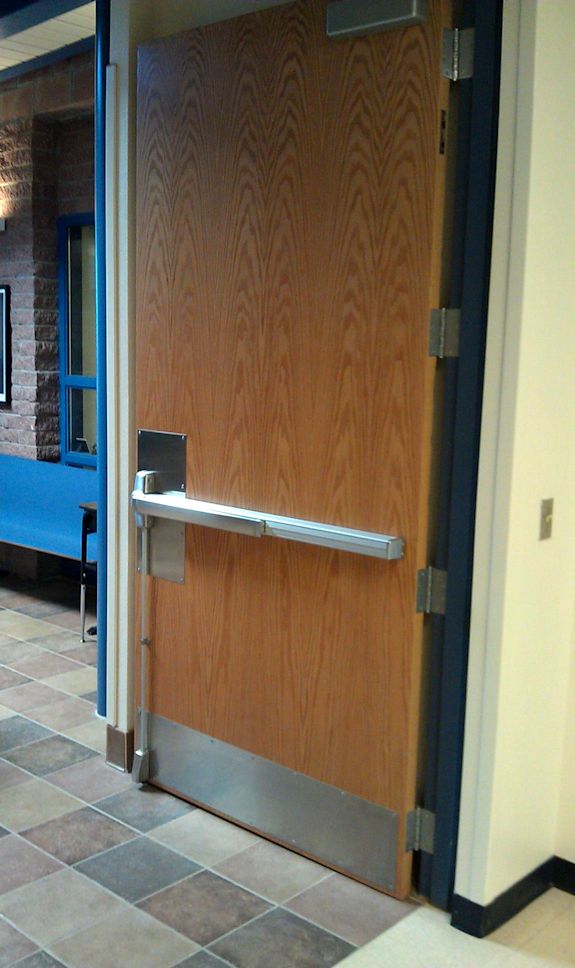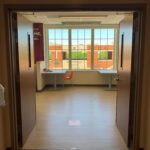In case you were wondering, this is not an acceptable application for a fire door. And I’m not sure if/how it’s working properly, or what’s under the big plate.
Photo submitted by Craig Burns of Ingersoll Rand Security Technologies.
You need to login or register to bookmark/favorite this content.






Sometimes all you can do is shake your head …
Wow… Sheet metal shop was working overtime making that plate…..
Interesting since most SVR devices key off the top latch to function.. Maybe it was a three point device at one time but omitting the top latch makes no sense…
The gap between the bottom latch and the floor concerns me too.. Looks excessive…
Maybe its a non latching door now and the bar is just to push on?
I would like more explanation regarding this door. I subscribe to this blog in order to learn more about doors and hardware and I don’t understand the potential problems with this door. The only thing I see is that there is a panic hardware over a push plate, but how does that impact the door being a fire-rated door? Thanks.
Hi Brenda –
Sorry I didn’t include more information. Typically on Wednesdays I post a photo illustrating an issue I’ve talked about before as a “Wordless Wednesday” post. The problems with this door are that you are not allowed to have a fire door with only the bottom rod and latch installed. With the fire exit hardware in the photo, you would either have rods and latches top and bottom, or you can omit the bottom rod and latch and install an auxiliary fire pin in the edge of the door. Here, the installer has installed the top rod and latch on the bottom, with no rod and latch on the top. Regarding the plate, my assumption is that the plate is covering something…most likely a hole. Covering a hole in a fire-rated wood door with a push plate is not an acceptable way to fill a hole.
You can always use the search box to find more information on my site about a topic.
Here is a post on filling holes in fire doors: http://idighardware.com/2012/08/filling-holes-in-fire-doors/
Here is a post on less bottom rod fire exit hardware: http://idighardware.com/2012/07/decoded-less-bottom-rod-fire-exit-hardware/
And here are a couple about fire door basics: http://idighardware.com/2012/10/fire-door-inspection-top-10-deficiencies/, http://idighardware.com/2013/10/fire-doors-everything-you-always-wanted-to-know-but-were-afraid-to-ask/
There are A LOT of technical articles on my Articles page, in case you can’t find what you’re looking for: http://idighardware.com/category/dhi/
I hope this information helps!
– Lori
Having seen this door in person I was amazed that the installer actually installed the top latch at the bottom of the door. The door was also prepped for the auxiliary fire bolt but not installed. Thankfully they didn’t try to install the 499F strike to the floor!
Hey Jason,
Wow! Would the device even function in theory with the top latch installed in the bottom postion?
ie maybe just testing the trigger on the latch with a screwdriver etc.?
And if the above is true any guess how long it would continue to function since top latches rely alot on mean old Mr. Gravity to function?
Thanks
This makes me think they installed them upside down. If I recall when you order an LBR device the case has a notch for the top rod only. They would have had to cut down the top rods just to make it fit on the door.
Lori-
Thanks for the information! I’m relatively new to your blog so I haven’t quite figured out your format yet. Usually on your Wednesday and Friday posts I can see what someone has done, but this one had me scratching my head. Thanks again!
Things that make you go “hmmmm”.
How would they get the top bar to fit on the bottom? I assume they cut it short. Are those bars typically cut to size in the field for top installations, too?
Hi Rosa –
You could put the top rod on the bottom, but using the top latch as the bottom latch is the part that’s really strange.
the latch is pullman latch
Looks to me like the device could have been ordered for the wrong hand, so the MECHANIC just cut the rod and flipped it over!